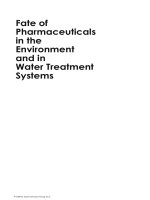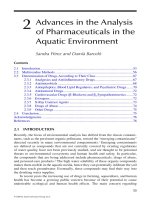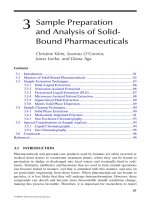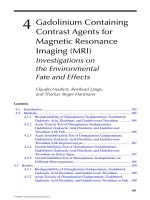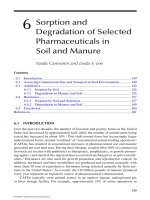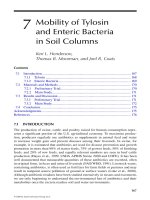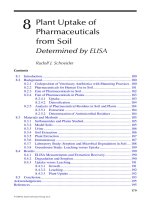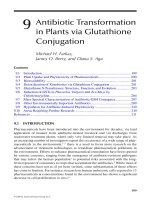Fate of Pharmaceuticals in the Environment and in Water Treatment Systems - Chapter 1 pot
Bạn đang xem bản rút gọn của tài liệu. Xem và tải ngay bản đầy đủ của tài liệu tại đây (820.31 KB, 61 trang )
)DWHRI
3KDUPDFHXWLFDOV
LQWKH
(QYLURQPHQW
DQGLQ
:DWHU7UHDWPHQW
6\VWHPV
© 2008 by Taylor & Francis Group, LLC
)DWHRI
3KDUPDFHXWLFDOV
LQWKH
(QYLURQPHQW
DQGLQ
:DWHU7UHDWPHQW
6\VWHPV
Edited by
Diana S. Aga
CRC Press is an imprint of the
Taylor & Francis Group, an informa business
Boca Raton London New York
© 2008 by Taylor & Francis Group, LLC
CRC Press
Taylor & Francis Group
6000 Broken Sound Parkway NW, Suite 300
Boca Raton, FL 33487-2742
© 2008 by Taylor & Francis Group, LLC
CRC Press is an imprint of Taylor & Francis Group, an Informa business
No claim to original U.S. Government works
Printed in the United States of America on acid-free paper
10 9 8 7 6 5 4 3 2 1
International Standard Book Number-13: 978-1-4200-5232-9 (Hardcover)
This book contains information obtained from authentic and highly regarded sources. Reprinted
material is quoted with permission, and sources are indicated. A wide variety of references are
listed. Reasonable efforts have been made to publish reliable data and information, but the author
and the publisher cannot assume responsibility for the validity of all materials or for the conse-
quences of their use.
Except as permitted under U.S. Copyright Law, no part of this book may be reprinted, reproduced,
transmitted, or utilized in any form by any electronic, mechanical, or other means, now known or
hereafter invented, including photocopying, microfilming, and recording, or in any information
storage or retrieval system, without written permission from the publishers.
For permission to photocopy or use material electronically from this work, please access www.
copyright.com ( or contact the Copyright Clearance Center, Inc. (CCC)
222 Rosewood Drive, Danvers, MA 01923, 978-750-8400. CCC is a not-for-profit organization that
provides licenses and registration for a variety of users. For organizations that have been granted a
photocopy license by the CCC, a separate system of payment has been arranged.
Trademark Notice: Product or corporate names may be trademarks or registered trademarks, and
are used only for identification and explanation without intent to infringe.
Library of Congress Cataloging-in-Publication Data
Fate of pharmaceuticals in the environment and in water treatment systems /
edited by Diana S. Aga.
p. cm.
Includes bibliographical references and index.
ISBN 978-1-4200-5232-9 (alk. paper)
1. Drugs Environmental aspects. 2. Water Pollution. 3. Water Purification.
I. Aga, Diana S., 1967- II. Title.
TD196.D78F38 2008
628.5’2 dc22 2007029935
Visit the Taylor & Francis Web site at
and the CRC Press Web site at
© 2008 by Taylor & Francis Group, LLC
v
Contents
Preface vii
Editor ix
Contributors xi
PART I Occurrence and Analysis of
Pharmaceuticals in the Environment
Chapter 1 Environmental Presence and Persistence of Pharmaceuticals:
An Overview 3
Susan T. Glassmeyer, Dana W. Kolpin, Edward T. Furlong,
and Michael J. Focazio
Chapter 2 Advances in the Analysis of Pharmaceuticals in the Aquatic
Environment 53
Sandra Pérez and Damià Barceló
Chapter 3 Sample Preparation and Analysis of Solid-Bound
Pharmaceuticals 81
Christine Klein, Seamus O’Connor, Jonas Locke, and Diana Aga
Chapter 4 Gadolinium Containing Contrast Agents for Magnetic
Resonance Imaging (MRI): Investigations on the
Environmental Fate and Effects 101
Claudia Neubert, Reinhard Länge, and Thomas Steger-Hartmann
PART II Environmental Fate and Transformations
of Veterinary Pharmaceuticals
Chapter 5 Fate and Transport of Veterinary Medicines in the Soil
Environment 123
Alistair B.A. Boxall
Chapter 6 Sorption and Degradation of Selected Pharmaceuticals in Soil
and Manure 139
Nadia Carmosini and Linda S. Lee
© 2008 by Taylor & Francis Group, LLC
vi Fate of Pharmaceuticals in the Environment and in Water Treatment Systems
Chapter 7 Mobility of Tylosin and Enteric Bacteria in Soil Columns 167
Keri L. Henderson,Thomas B. Moorman, and Joel R. Coats
Chapter 8 Plant Uptake of Pharmaceuticals from Soil: Determined
by E LISA 179
Rudolf J. Schneider
Chapter 9 AntibioticTransformationinPlantsviaGlutathione
Conjugation 199
Michael H. Farkas, James O. Berry, and Diana S. Aga
PART III Treatment of Pharmaceuticals in Drinking
Water and Wastewater
Chapter 10 Drugs in Drinking Water: Treatment Options 217
Howard S. Weinberg, Vanessa J. Pereira, and Zhengqi Ye
Chapter 11 Removal of Endocrine Disruptors and Pharmaceuticals during
Water Treatment 229
Shane A. Snyder, Hongxia Lei, and Eric C. Wert
Chapter 12 ReactionandTransformationofAntibacterialAgentswith
Aqueous Chlorine under Relevant Water Treatment Conditions 261
Ching-Hua Huang, Michael C. Dodd, and Amisha D. Shah
Chapter 13 Hormones in Waste from Concentrated Animal Feeding
Operations 291
Z. Zhao, K.F. Knowlton, and N.G. Love
Chapter 14 Treatment of Antibiotics in Swine Wastewater 331
Craig D. Adams
Chapter 15 Removal of Pharmaceuticals in Biological Wastewater
Treatment Pla nts 349
Sungpyo Kim, A. Scott Weber, Angela Batt, and Diana S. Aga
Chapter 16 Chemical Processes dur ing Biological Wastewater Treatment 363
Willie F. Harper, Jr., Tamara Floyd-Smith, and Taewoo Yi
© 2008 by Taylor & Francis Group, LLC
vii
Preface
Recentadvancesinanalyticalinstrumentationhavebeenmirroredbyourincreased
abilitytodetectandquantifyorganiccontaminantsattracelevels,eveninhighly
complexmatricessuchaswastewater,manure,andsoil.Incontrasttothehydro-
phobicpersistentorganicpollutants(forexample,PCBs,DDT)thatareoftenfound
in the environment at parts-per-million or parts-per-billion concentrations, pharma-
ceutical compounds are generally present at the parts-per-trillion or low parts-per-
billion range and are mostly polar. Consequently, the detection of pharmaceutical
residues in the environment remained elusive until modern instruments such as liq-
uid chromatography/mass spectrometry (LC/MS) became commonplace in many
environmental laboratories. As a result, many scientists have now documented the
occurrence of residues of pharmaceuticals and personal-care products, which have
been termed “emerging contaminants” in various environmental compartments.
Questionsregardingpersistenceandlong-termadverseeffectsofpharmaceuticals
in the environment have been raised because there have been reports that very low
drug concentrations (for example, ng/L) in the environment can have undesirable
ecological and potentially human health effects.
The rst section of this book, “Occurrence and Analysis of Pharmaceuticals in
the Environment,” includes a chapter prepared by leading researchers from the U.S.
EnvironmentalProtectionAgencyandtheU.S.GeologicalSurvey,whichprovides
an overview of the momentous publications that have been instrumental in the recog-
nition of emerging contaminants. A compilation of the most current (2004 through
2006) literature on the presence and concentrations of pharmaceuticals in the envi-
ronment is also presented. This information is complemented by the subsequent
review chapters on the recent advances in instrumentation and sample preparation
techniquesinenvironmentalanalysisthathaveplayedacriticalroleintheadvance-
ment of our knowledge on the environmental fate of pharmaceuticals. Finally, an
example of how risk assessment is conducted to investigate the fate and effects of
pharmaceutical contaminants is included in this rst section.
Animportantsourceofpharmaceuticalcontaminantsisthroughlandapplica-
tion of livestock manure to fertilize crops. Many animal operations generate manure
thatcontainsantibioticssinceanimalsreceivethesedrugsinfeedrations,eitheras
growthpromotersorastherapeuticagents.Therefore,thesecondsectionofthis
book, “Environmental Fate and Transformations of Veterinary Pharmaceuticals,”
is dedicated to chapters that explore the behavior of pharmaceuticals in soil and the
potential effects of antibiotics on plants after uptake.
Pharmaceuticals are also introduced into the environment via wastewater treat-
mentplants(WWTPs),whicharecurrentlynotdesignedandoperatedtoremove
low concentrations of organic contaminants. Because increasing amounts of treated
wastewaterarerecycledforindustrialanddomesticuse,itisimportanttoimprove
treatment technologies for both wastewater and drinking water sources. Therefore,
thethirdsectionofthisbook,“TreatmentofPharmaceuticalsinDrinkingWaterand
© 2008 by Taylor & Francis Group, LLC
viii Fate of Pharmaceuticals in the Environment and in Water Treatment Systems
Wastewater,” includes chapters that examine various treatment processes that can be
employed to reduce the concentrations of pharmaceuticals at the source.
This book covers important issues regarding the analysis, occurrence, persis-
tence, treatment, and transformations of pharmaceuticals in the environment. Topics
range from eld studies documenting the occurrence of pharmaceuticals in sev-
eral environmental compartments to laboratory studies determining the degrada-
tion kinetics and formation of byproducts during treatment. This book will provide
information that will help scientists, regulators, and engineers understand the factors
that affect the environmental fate of pharmaceuticals in soil and water to facilitate
the development of best management practices and optimize treatment systems for
effective removal of these compounds in the environment.
Diana S. Aga
Department of Chemistry
Univers ity at Buffalo
Buffalo, New York
© 2008 by Taylor & Francis Group, LLC
ix
Editor
Diana Aga, Ph.D., is an associate professor of chemistry at the University at Buffalo,
The State University of New York. Her current research involves the investigations
on the fate, transport, and ecotoxicological effects of pharmaceuticals, endocrine-
disrupting chemicals, and persistent organic pollutants in the environment. A major
focusofherresearchistoidentifyunknowntransformationproductsofpharmaceu-
ticals in various environmental matrices (for example, manure, plants, soil, waste-
water) using a combination of novel strategies in sample preparation, bioassays, and
modern mass spectrometric techniques. Dr. Aga received her B.S. in agricultural
chemistry at the University of the Philippines at Los Baños (1988) and her Ph.D. in
environmental and analytical chemistry at the University of Kansas (1995). She was
aresearchassistantattheU.S.GeologicalSurvey,Lawrence,Kansas(1993–1996),
andapostdoctoralfellowattheSwissFederalInstituteofAquaticScienceandTech-
nology (EAWAG), Switzerland (1996–1998). Dr. Aga is recipient of various research
awards, such as the National Science Foundation CAREER Award, the North Atlan-
tic Treaty Organization Scientic and Environmental Affairs Fellowship, and the
Alexander von Humboldt Research Fellowship.
© 2008 by Taylor & Francis Group, LLC
xi
Craig D. Adams
Department of Civil, Architectural,
and Environmental Engineering
University of Missouri at Rolla
Rolla, Missouri
Damià Barceló
DepartmentofEnvironmental
Chemistry
IIQAB-CSIC
Barcelona, Spain
Angela Batt
National Exposure Research
Laboratories
OfceofResearchandDevelopment
U.S.EnvironmentalProtection
Agency
Cincinnati, Ohio
James O. Berry
BiologyDepartment
UniversityatBuffalo
Buffalo, New York
Alistair B.A. Boxall
CentralScienceLaboratory
UniversityofYork
SandHutton,York
United Kingdom
Nadia Carmosini
DepartmentofAgronomy
PurdueUniversity
West Lafayette, Indiana
Joel R. Coats
Department of Entomology
Iowa State University
Ames, Iowa
Michael C. Dodd
SwissFederalInstituteofAquatic
Science and Technology (EAWAG)
Duebendorf, Switzerland
Michael H. Farkas
Biology Department
University at Buffalo
Buffalo, New York
Tamara Floyd-Smith
Department of Chemical Engineering
Tuskegee Un iversit y
Tuskegee, Alaba ma
Michael J. Focazio
U.S.GeologicalSurvey
Reston, Virginia
Edward T. Furlong
U.S.GeologicalSurvey
Denver, Colorado
Susan T. Glassmeyer
National Exposure Research
Laboratory
OfceofResearchandDevelopment
U.S.EnvironmentalProtection
Agency
Cincinnati, Ohio
Willie F. Harper, Jr.
DepartmentofCivilEngineering
AuburnUniversity
Auburn, Alabama
Keri L. Henderson
DepartmentofEntomology
Iowa State University
Ames, Iowa
Contributors
© 2008 by Taylor & Francis Group, LLC
xii Fate of Pharmaceuticals in the Environment and in Water Treatment Systems
Ching-Hua Huang
SchoolofCivilandEnvironmental
Engineering
G
e
orgiaInstituteofTechnology
Atlanta, Georgia
Sungpyo Kim
DepartmentofEarthand
EnvironmentalEngineering
Columbia University
Ne
wYork
Christine Klein
DepartmentofChemistry
Un
iversityatBuffalo
Buffalo, New York
K.F. Knowlton
DepartmentofDairyScience
VirginiaPolytechnicInstituteand
StateUniversity
Blacksburg, Virginia
Dana W. Kolpin
U.
S. Geological Survey
Iowa City, Iowa
Reinhard Länge
BayerScheringPharma
Nonclinical Drug Safety
B
e
rlin, Germany
Linda S. Lee
De
partment of Agronomy
Purdue University
West Lafayette, Indiana
Hongxia Lei
WaterQualityResearchand
D
e
velopmentDivision
Southern Nevada Water Authority
La
sVegas,Nevada
Jonas Locke
DepartmentofChemistry
University at Buffalo
Bu
ffalo, New York
N.G. Love
DepartmentofCiviland
EnvironmentalEngineering
Virginia Polytechnic Institute and
St
ate University
Blacksburg, Virginia
Thomas B. Moorman
U.S. Department of Agriculture–
Agricultural Research Service
(ARS)
National Soil Tilth Laboratory
Ames, Iowa
Claudia Neubert
BayerScheringPharma
No
nclinicalDrugSafety
Berlin,Germany
Seamus O’Connor
DepartmentofChemistry
University at Buffalo
B
u
ffalo, New York
Vanessa J. Pereira
InstitutodeBiologiaExperimentale
Tecnólogica
Oeiras,
Portugal
Sandra Pérez
DepartmentofEnvironmental
Chemistry
Consejo Superior de Investigaciones
C
i
enticas (CSIC)
Barcelona, Spain
Rudolf J. Schneider
DepartmentofAnalyticalChemistry:
Re
ferenceMaterials
Federal Institute for Materials
Re
search and Testing
Berlin, Germany
Amisha D. Shah
SchoolofCivilandEnvironmental
Engineering
Georgia Institute of Technology
A
tlanta, Georgia
© 2008 by Taylor & Francis Group, LLC
Contributors xiii
Shane A. Snyder
WaterQualityResearchand
De
velopmentDivision
Southern Nevada Water Authority
La
sVegas,Nevada
Thomas Steger-Hartmann
BayerScheringPharma
Nonclinical Drug Safety
B
e
rlin, Germany
A. Scott Weber
DepartmentofCivil,Structural,and
E
n
vironmentalEngineering
UniversityatBuffalo
Buffalo,NewYork
Howard S. Weinberg
De
partment of Environmental
Sciences and Engineering
UniversityofNorthCarolina
C
h
apelHill,NorthCarolina
Eric C. Wert
WaterQualityResearchand
De
velopmentDivision
SouthernNevadaWaterAuthority
LasVegas,Nevada
Zhengqi Ye
EnthalpyAnalytical,Inc.
Du
rham,NorthCarolina
Taewoo Yi
DepartmentofCivilEngineering
Au
burnUniversity
Auburn,Alabama
Z. Zhao
DepartmentofDairyScience
V
i
rginiaPolytechn ic Institute and
St
ate University
Blacksburg, Virginia
© 2008 by Taylor & Francis Group, LLC
Part I
Occurrence and Analysis
of Pharmaceuticals
in the Environment
© 2008 by Taylor & Francis Group, LLC
3
1
Envir onmental Presence
and Persistence of
Pharmaceuticals
An Overview
Susan T. Glassmeyer, Dana W. Kolpin,
Edward T. Furlong, and Michael J. Focazio
1.1 INTRODUCTION
Emerging contaminants (ECs) in the environment—that is, chemicals with domestic,
municipal, industrial, or agricultural sources that are not commonly monitored but
mayhavethepotentialforadverseenvironmentaleffects—isarapidlygrowingeld
of research. The use of “emerging” is not intended to infer that the presence of these
compoundsintheenvironmentisnew.Thesechemicalshavebeenreleasedintothe
environmentaslongastheyhavebeeninproductionor,inthecaseofhormonesand
other endogenous compounds, since the rise of animal life. What is emerging is the
interest by the scientic and lay communities in the presence of these chemicals in
the environment, the analytical capabilities required for detection, and the subtle
effectsthatverysmallconcentrationsofthesechemicalsappeartohaveonaquatic
biota. In December 2006, Environmental Science & Technology devotedanentire
specialissue(volume40,number23)tothetopicofECs,illustratingtheincreased
interestinthesubject.WithintheECs,oneparticularclassthathasseenasubstan-
tial increase in research over the past 10 years is pharmaceuticals and personal-care
products (PPCPs). This increased research interest can be demonstrated by several
means, including requests for proposals from funding agencies, but the clearest indi-
cationofafocusedefforttounderstandtheintroduction,transformation,andpoten-
tialhealthandenvironmentaleffectsofPPCPsandECs,ingeneral,isthenumber
ofpublishedreports.Thisincreasecanbeshownbyexaminingsixenvironmental
journals that regularly publish PPCP-related papers—Chemosphere, Environmental
Science & Technology, Environmental Toxicology and Chemistry, Science of the
Contents
1.1 Introduction 3
1.2 Overview of Recent Literat u re 5
1.3 Int roduct ion into the Environ ment 35
1.4 Environmental Presence and Fate 37
References 41
© 2008 by Taylor & Francis Group, LLC
4 Fate of Pharmaceuticals in the Environment and in Water Treatment Systems
Total Environment, Water Research, and Water Science and Technology.In1998
there were 22 papers published on pharmaceuticals, antibiotics, or drugs in these 6
journals;by2006,thisnumberincreasedsixfoldto132papers(Figure 1.1).
Thisgrowthcanbeattributedtoanumberoffactors.Thepresenceofpharma-
ceuticalsinsurface-watersamplesfromEuropeandtheUnitedStateswasdocu-
mented in several sentinel papers.
1–4
These ground-breaking works encouraged
other scientists to examine the rivers, streams, lakes, and reservoirs in their regions
forsuchchemicals.Inadditiontheintensepublicattentionpaidtonewsreportson
the environmental detections of these chemicals and possible effects on aquatic life
has made this issue visible to the wastewater-treatment, drinking-water treatment,
and regulatory communities. This has driven the funding bodies associated with
these communities to fund studies or request proposals that address the presence,
fate, and effects of PPCPs in aquatic systems. The release of the rst comprehensive
reconnaissance of pharmaceuticals and other wastewater contaminants in the United
States
2
providesanexampleoftheintensemediainterestinthistopic.Within6days
of online publication of this study, 72 newspapers across the United States had pub-
lished articles describing the results, either locally written or based on international
media syndicate reports. There also was substantial concurrent coverage by local
and national radio and television outlets, including the Cable News Network, ABC
World News Tonight, and National Public Radio. A substantial fraction of these news
stories may be attributable to press releases and media briengs prior to publication.
However,theinterestbytelevisionandprintjournalistsinreportingtheresultsofa
peer-reviewedjournalarticletothegeneralpublicwasmotivatedbytherecognition
that describing the presence of PPCPs in water supplies would be of interest to the
public.TobetterconveytheresultsofthestudypublishedbyKolpinetal.
2
tothe
0
20
40
60
80
100
120
140
1998 1999 2000 2001 2002 2003 2004 2005 2006
Publication Year
Number of Publications
FIGURE 1.1 Cumulative yearly number of pharmaceutical-related papers published in six
environmentaljournalsfrom1998to2006.
© 2008 by Taylor & Francis Group, LLC
Environmental Presence and Persistence of Pharmaceuticals 5
public,aseparategeneral-interestfactsheetwaspublishedtosummarizetheimpor-
tantpointsofthestudy.
5
Because PPCPs are commonly and widely used by indi-
viduals,thereislikelyapreexisting,personalidenticationwiththesecompounds
that does not occur for the wide range of other organic and inorganic contaminants
whose presence in the environment has previously been described. This greater pub-
li
c“namerecognition”makesitselfknownthroughthemediatotheregulatoryand
technical community and has prompted interest in sponsoring research that denes
the composition and concentrations of PPCPs in potential sources and their fate and
effects following release into the environment.
Independent of the drivers that potentially fuel the interest in studies of PPCPs,
it is clear that PPCP research has grown beyond surface-water studies to examine
issues such as:
Presenceinothermatrices,suchasgroundwater,
6–11
landll leachates,
12–15
sediments,
16,17
and biosolids.
18,19
Environmental transport and fate in surface water,
20–23
groundwater,
8,9,24–30
andsoilsamendedwithreclaimedwater
31,32
or biosolids.
33–35
PPCP source elucidation, such as wastewater treatment plant (WWTP)
efuents,
20,23,36–40
conned animal feeding operations (CAFOs),
41,42
and
aquaculture.
43,44
Removal during wastewater
23,45–53
and drinking-water
10,54–61
treatment.
Effects on aquatic ecosystems,
62–66
terrestrial ecosystems,
67,68
and human
health.
69,70
The chapters in this book provide an extensive examination of current environ-
mental pharmaceutical research and are divided into three sections: “Occurrence
and Analysis of Pharmaceuticals in the Environment,” “Environmental Fate and
Transformations of Veterinary Pharmaceuticals,” and “Treatment of Pharmaceuti-
cal
sinDrinkingWaterandWastewater.”Thepurposeofthisintroductoryoverview
chapteristooutlinecurrent(2004–2006)knowledgeaboutthepresenceandcon-
ce
ntrationofPPCPsasdescribedinthepublishedliterature.Previousreviews
1,71–73
shouldbeconsultedfordiscussionsonpre-2004publications.Thosereviewswill
providethereaderwithacomprehensiveintroductiontothetopicofPPCPsinthe
environment. This chapter describes the sources of PPCPs and other organic con-
ta
minants often associated with human wastewater into the environment, the range
of concentrations present in various environmental compartments, and the potential
routes of removal/sequestration. An overview of the sources and fate of veterinary
pharmaceuticals will be discussed in Chapter 5, “Fate and Transport of Veterinary
MedicinesintheSoilEnvironment.”
1.2 OVERVIEW OF RECENT LITERATURE
Between January 2004 and July 2006, more than 80 papers were published dis-
cussing the worldwide presence of PPCPs in different environmental compartments,
such as raw and treated wastewater and surface water(
Table 1.1),biosolidsandslud-
ges,sediments,groundwater,anddrinkingwater(Table 1.2).Figure 1.2 isananaly-
si
softhepaperslistedinTable1.1andTable1.2 , categorized b
ysamplelocation.
•
•
•
•
•
© 2008 by Taylor & Francis Group, LLC
6 Fate of Pharmaceuticals in the Environment and in Water Treatment Systems
AlthoughtheUnitedStateshadthemostrecentlypublishedpapersofanyindividual
country, the total number of publications from Europe slightly exceeds those from
NorthAmerica.Thisresultlikelyreectstheearlierattentionpaidtotheenviron-
me
ntal presence of PPCPs in Europe, particularly in Germany, Switzerland, Italy,
andtheUnitedKingdom.Theglobalnatureofthisissueisillustratedbythenumber
of countries reporting studies. Whereas PPCPs once were only found on Western
European and North American research agendas, the importance of the issue has
resulted in the expansion of studies into other parts of the world, including Eastern
Europe and Asia.
74–78
The presence of PPCPs also has been reported for some of
thecountriesmissingfromthislist,suchasAustraliaandBrazil,inarticlesthat
predatethetimeaddressedinthisreview.Theirabsencelikelyreectsthetimingof
publication and the publication in journals that were missed in the searches used for
this review. However, in many other regions of the world where detection of these
compoundswouldbeexpected,suchasurbanizedwatershedsinLatinAmerica,
Africa, the Middle East, and China, no concentrations have been reported in the
literature.
79
TheremaybedecreasedaccesstoPPCPsinsomeoftheremoteparts
of these regions; however, wastewater and drinking-water treatment in these same
regionsisalsolikelytobeminimal.Therefore,detectable,andperhapssubstantial,
concentrations would be expected. Studies are necessary to assess the concentration
and composition of PPCPs present in the aquatic environments of these regions to
determine the potential for the environmental effect of PPCPs in regions of the globe
with rapidly growing populations and less advanced water treatment.
Inthe80paperscitedi
nTable1.1a
ndTable 1.2, detections and concentrations
for more than 120 chemicals were reported. It should be noted that “nondetections”
0
5
10
15
20
25
30
U
SA
C
anada
Spain
G
erm
an
y
Sw
eden
Italy
U
K
M
ultiple E
uropean
A
ustria
Fin
lan
d
Japan
Fran
ce
Sw
itzerland
N
orw
ay
C
roatia
R
om
an
ia
Sloven
ia
T
aiw
an
Country
Number of Publications
FIGURE 1.2 Distribution of recent publications on pharmaceuticals and personal-care
products by location sampled.
© 2008 by Taylor & Francis Group, LLC
Environmental Presence and Persistence of Pharmaceuticals 7
TABLE1.1
Concentrations of Pharmaceuticals and Other Emerging Contaminants in Wastewater Influents, Effluents, and Surface
Water, Reported in the Literature Since 2004
Compound CAS Number
WWTP Influent
Concentration
μg/L Reference
WWTP Effluent
Concentration
μg/L Reference
Surface-Water
Concentration
μg/L Reference
1,4-dichlorobenzene 106-46-7 nd
a
-0.91 (0.11) 20 nd-0.28 (nd)
0.027-0.098
0.095 max
b
20
116
102
1,7-dimethylxanthine 611-59-6 nd-8.55 (nd) 20 nd-1.76 (nd)
0.294 max
20
102
17-alpha-ethynyl estradiol 57-63-6
0.1-0.13 117
17-beta-estradoil 50-28-2 0.003-0.022 (0.009)
0.0081med
c
45
118
nd-0.002 (0.002) 45 0.1 only
d
nd-0.005
117
119
1-methylnaphthalene 90-12-0 nd-0.1 (nd) 20 nd-0.095 (nd) 20
2-methylnaphthalene 91-57-6 nd-0.06 (nd) 20 nd-0.061 (nd)
0.056 max
20
102
3,4-dichlorophenyl isocyanate 102-36-3
0.047-0.32 (0.15) 20 nd-0.28 (0.047)
0.055-0.23
20
112
a
nd = not detected
b
max = maximum concentration reported
c
med = median concentration reported
d
only = only measured concentration reported
e
ave = average concentration reported
Note: Entries in bold are concentrations reported for multiple related compartments in individual studies. For concentration ranges, the median (if available) is pre-
sented in parentheses.
© 2008 by Taylor & Francis Group, LLC
8 Fate of Pharmaceuticals in the Environment and in Water Treatment Systems
TABLE1.1
(Continued)
Compound CAS Number
WWTP Influent
Concentration
μg/L Reference
WWTP Effluent
Concentration
μg/L Reference
Surface-Water
Concentration
μg/L Reference
4-cumylphenol 599-64-4
nd-0.76 116
4-tert-octylphenol 140-66-9 0.38-3.56 (3.08) 45 0.01-0.47 (0.06)
nd-1.1 (nd)
45
20
0.02-0.19
nd-0.29 (nd)
nd-0.18
0.22 max
117
20
116
102
5-methyl-1h-benzotriazole 136-85-6
nd-1.7 (0.82) 20 nd-1.1 (nd)
0.27 max
20
102
acetaminophen 103-90-2 0.13-26.09
5.529-69.57
23
53
nd-5.99
nd-1.06 (0.006)
nd-9
0.5-29
23
20
40
120
nd-0.25
nd-1.78 (nd)
nd-3.6
nd-0.066
0.555 max
0.025-0.065
1.95 max
nd-0.014
23
20
40
121
103
119
102
112
acetophenone 98-86-2 nd-0.26(nd) 20 nd-0.78 (nd)
0.22 max
20
102
albuterol 18559-94-9 nd-0.0327 (nd)
0.009 med
20
36
nd-0.343 (nd)
0.001 med
0.003 max
0.268 max
20
36
122
103
alkylphenol 68555-24-8 nd-6.2 37 nd-1.3 37
anthraquinone 84-65-1 nd-0.096 20 nd-0.58 (nd)
0.066 max
nd-0.073
20
102
112
© 2008 by Taylor & Francis Group, LLC
Environmental Presence and Persistence of Pharmaceuticals 9
Compound CAS Number
WWTP Influent
Concentration
μg/L Reference
WWTP Effluent
Concentration
μg/L Reference
Surface-Water
Concentration
μg/L Reference
aspirin 50-78-2
nd-0.037 77
atenolol 29122-68-7 nd-0.74
0.03 only
23
50
nd-1.15
0.16 only
0.466 med
0.19 med
0.1-122
23
50
36
123
120
nd-0.25
0.06 max
0.017 med
0.042 max
23
50
36
122
azithromycin 83905-01-5 nd-0.3
0.09-0.38 (0.17)
0.26ave
e
23
87
78
0.05-0.21
0.08-0.4 (0.16)
0.085-0.255
0.015-0.066
23
87
124
113
nd-0.02 23
bezabrate 41859-67-0 nd-0.05
2.775 ave
1.738 ave
2.2 ave
2.6 ave
1.55-7.6
1.9 only
23
46
47
125
48
49
126
nd-0.01
0.565 ave
0.018 ave
0.14 ave
0.24 ave
nd-4.8
0.0548 med
nd-0.81
0.004-0.024
23
46
47
125
48
49
36
40
38
nd-0.01
0.847 ave
nd-0.088
0.003 max
0.78 max
0.002 med
nd-0.47
nd-0.004
23
46
121
122
104
36
40
38
benzophenone 119-61-9 0.081-0.61 (0.2) 20 nd-0.51 (0.06)
nd-0.16
0.11 max
nd-0.17
20
116
102
112
(Continued)
© 2008 by Taylor & Francis Group, LLC
10 Fate of Pharmaceuticals in the Environment and in Water Treatment Systems
TABLE1.1
(Continued)
Compound CAS Number
WWTP Influent
Concentration
μg/L Reference
WWTP Effluent
Concentration
μg/L Reference
Surface-Water
Concentration
μg/L Reference
bha (butylated hydroxyanisole) 25013-16-5
nd-0.32 (nd) 20 nd-0.23 (nd) 20
bht
(butylated hydroxytoluene) 128-37-0 2.53 only 50 0.61 only 50 0.47 max 50
bisphenol A 80-05-7 0.72-2.376
0.21-2.4 (1.28)
49
45
0.026-1.53
0.02-0.45 (0.18)
nd-0.31 (0.12)
49
45
20
nd-0.114
0.01-0.02
nd-0.3 (nd)
nd-0.147
0.7 max
nd-0.23
121
117
20
119
102
112
bromacil 314-40-9 nd-0.69 (nd) 20 nd-0.34 (nd)
nd-0.79
0.39 max
20
116
102
bromoform 75-25-2 nd-0.22 (nd) 20 nd-0.62 (nd)
nd-0.041
0.16
max
nd-0.071
20
116
102
112
caffeine 58-08-2 3.69 only
16.3 max
42.4-43.8
50
51
127
0.22 only
4.52 max
0.013-0.036
nd-7.99 (0.0532)
nd-9.9
1.742-8.132
0.46-1.56
0.036
ave
50
51
127
20
22
39
128
129
0.11 max
nd-0.88
nd-0.038
nd-2.6 (0.0458)
nd-0.31
nd-1.59
0.428-9.7
1.39
max
0.021-0.055
50
116
119
20
22
39
77
102
112
© 2008 by Taylor & Francis Group, LLC
Environmental Presence and Persistence of Pharmaceuticals 11
Compound CAS Number
WWTP Influent
Concentration
μg/L Reference
WWTP Effluent
Concentration
μg/L Reference
Surface-Water
Concentration
μg/L Reference
camphor 76-22-2 nd-0.13 (nd) 20 nd-0.084 (nd)
0.084
20
102
carbamazepine 298-46-4 1.68 only
nd-0.95
2.1 max
1.45 med
0.356 ave
0.325-1.85
50
23
51
130
52
49
1.18 only
nd-0.63
0.75 max
1.65 med
0.251 ave
0.465-1.594
50
23
51
130
52
49
0.5 max
nd-0.11
nd-7.1
0.043 max
1.15 max
0.043-0.114
50
23
121
10
104
119
nd-0.27 (0.0802)
0.291 med
nd-0.24
nd-0.059
0.42 (only)
0.44 med
0.03-0.07
20
36
40
37
75
123
120
nd-0.186 (0.03)
0.023 med
nd-0.17
nd-0.075
nd-0.024
0.263 max
0.0002-0.016
0.044-0.13
20
36
40
77
131
102
132
112
carbaryl 63-25-2
nd-0.22 (nd)
nd-0.076
20
116
chlortetracycline 64-72-2 0.26 133 nd-0.16
0.192 only
0.1 max
133
131
102
cholesterol 57-88-5 nd-8.7 (2) 20 nd-8 (0.89)
nd-1.6
4.3 max
20
116
102
(Continued)
© 2008 by Taylor & Francis Group, LLC
12 Fate of Pharmaceuticals in the Environment and in Water Treatment Systems
Compound CAS Number
WWTP Influent
Concentration
μg/L Reference
WWTP Effluent
Concentration
μg/L Reference
Surface-Water
Concentration
μg/L Reference
cimetidine 51481-61-9 nd-0.426 (nd) 20 nd-0.354 (nd)
0.338
max
20
102
ciprooxacin 85721-33-1 0.09-0.3
0.228 max
nd-0.21
3.6-101
134
100
135
136
nd-0.06
0.054 max
nd-0.14
0.251 med
0.091-5.6
nd-0.37
134
100
135
36
22
137
0.026 max
nd-0.039
0.03 max
0.014 only
0.031-0.36
122
116
102
36
22
clarithromycin 81103-11-9 0.33-0.6 (0.38)
0.647
87
78
0.11-0.35 (0.24)
0.018 med
0.22-0.329
87
36
124
0.02 max
0.002 med
122
36
clindamycin 18323-44-9 nd-1 22 nd-0.14 22
clobric acid 882-09-7 nd-0.36
0.163 ave
0.098 ave
nd-0.651
0.34 only
23
46
47
53
126
0.02-0.03
0.109 ave
0.023 ave
nd-0.044
nd-0.038
23
46
47
53
40
0.01-0.02
0.279 ave
nd-0.022
0.003-0.027
23
46
121
119
clotrimazole 23593-75-1 0.023-0.033 53 0.01-0.027 53 0.006-0.034 53
codeine 76-57-3 nd-0.73 (0.139)
0.01-5.7
20
120
nd-0.217 (0.0092)
nd-0.054
0.119 max
20
77
102
coprostanol 360-68-9 nd-5.9 (1.3) 20 nd-5.6 (0.26)
nd-1.5
1.3 max
20
116
102
TABLE1.1
(Continued)
© 2008 by Taylor & Francis Group, LLC
Environmental Presence and Persistence of Pharmaceuticals 13
Compound CAS Number
WWTP Influent
Concentration
μg/L Reference
WWTP Effluent
Concentration
μg/L Reference
Surface-Water
Concentration
μg/L Reference
cotinine 486-56-6 nd-1.03 (0.024) 20 nd-0.481 (0.0183)
nd-0.052
0.528
0.013-0.024
20
116
102
112
dehydronifedipine 67035-22-7 nd-0.0214 (0.0112) 20 nd-0.0216 (0.0026)
0.01 max
0.0051-0.018
20
102
112
demeclocyclin 127-33-3 1.14 only 133 0.09 only 133 nd-0.53 133
dextropropoxyphene 469-62-5 0.022-0.033 53 0.037-0.064
nd-0.585 (0.195)
53
21
nd-0.098
nd-0.682 (0.058)
53
21
diazepam 439-14-5 0.31 only 126 nd-0.034 77
dibutyl phthalate
84-74-2 0.15 only 50 0.03 only 50 0.06 max
0.11-6.58
50
117
diisobutyl phthalate 84-69-5 0.04 only 50 0.01 only 50 0.02 max 50
diclofenac 15307-86-5 0.16 only
0.05-0.54
2.333 ave
1.532 ave
0.46 ave
0.28 ave
0.905-4.11
0.901-1.036
0.14 med
0.05-2.45 (0.17)
50
23
46
47
125
48
49
53
118
45
0.12 only
nd-0.39
1.561 ave
0.437 ave
0.4 ave
1.9 ave
0.78-1.68
0.261-0.598
0.14 med
0.07-0.25 (0.11)
50
23
46
47
125
48
49
53
118
45
0.12 max
nd-0.06
0.272 ave
nd-0.069
nd-0.282
(nd)
50
23
46
121
74
(Continued)
© 2008 by Taylor & Francis Group, LLC
14 Fate of Pharmaceuticals in the Environment and in Water Treatment Systems
Compound CAS Number
WWTP Influent
Concentration
μg/L Reference
WWTP Effluent
Concentration
μg/L Reference
Surface-Water
Concentration
μg/L Reference
diclofenac (cont’d)
0.33-0.49
4.1
only
127
126
nd-2.349 (0.424)
nd-0.5
0.011-0.04
0.032-0.457
0.29 med
0.06-1.9
21
40
38
39
123
120
nd-0.568 (nd)
nd-0.089
nd-0.003
21
40
38
diethyl phthalate
84-66-2 0.19 only 50 0.02
nd-0.71 (nd)
50
20
0.03 max 50
diethylhexyl phthalate
117-81-7 0.27 only 50 0.02
nd-27 (nd)
50
20
0.04 max
nd-7.5 (nd)
nd-12.74
50
20
117
diltiazem
42399-41-7 nd-0.146 (0.0491) 20 nd-0.0736 (0.0042)
0.106 max
20
102
diphenhydramine 58-73-1
nd-0.387 (0.0784) 20 nd-0.273 (nd)
0.023 max
nd-0.0058
20
102
112
d-limonene
5989-27-5
0.029 only
0.94 max
116
102
doxycycline
564-25-0 0.22 only
nd-2.21
0.6-6.7
133
134
136
0.09 only
nd-0.88
133
134
nd-0.08
nd-0.073
133
131
TABLE1.1
(Continued)
© 2008 by Taylor & Francis Group, LLC
Environmental Presence and Persistence of Pharmaceuticals 15
Compound CAS Number
WWTP Influent
Concentration
μg/L Reference
WWTP Effluent
Concentration
μg/L Reference
Surface-Water
Concentration
μg/L Reference
enalaprilat
76420-72-9
0.0005 max
0.0001 med
122
36
enrooxacin
93106-60-6 0.1 max 128 0.01 max 102
erythromycin
114-07-8 0.71-0.141 53 0.145-0.29
0.047med
nd-1.842 (nd)
0.01-0.03
53
36
21
120
nd-0.07
0.003 med
nd-1.022 (nd)
0.016 max
nd-0.175
53
36
21
122
116
nd-0.051
nd-0.03
nd-0.007
131
23
132
erythromycin-H2O
(anyhydro-erythromycin)
114-07-8 0.2 ave
0.06-0.19 (0.07)
nd-1.2
0.09-0.35
138
87
135
139
0.08 ave
0.06-0.11 (0.07)
nd-0.3
0.04-0.12
nd-0.48 (0.15)
0.055-0.075
138
87
135
139
20
124
0.17 only
nd-1.209
0.22 max
nd-0.61 (nd)
138
116
102
20
estrone
53-16-7 0.032 med
0.008-0.052 (0.016)
2.4 max
118
45
140
0.013 med
nd-0.054 (0.005)
4.4 max
118
45
140
nd-0.022 (0.004)
nd-0.005
7
119
estrone-3-sulfate
481-97-0
nd-0.007 (0.006) 7
ethyl citrate
77-93-0 0.11-0.52 (0.27) 20 nd-0.4 (0.072)
nd-0.27
0.17 max
20
116
102
uoxetine
54910-89-3 0.0004-0.0024 141 nd-0.0013 141 nd-0.0212 (nd) 20
(Continued)
© 2008 by Taylor & Francis Group, LLC
